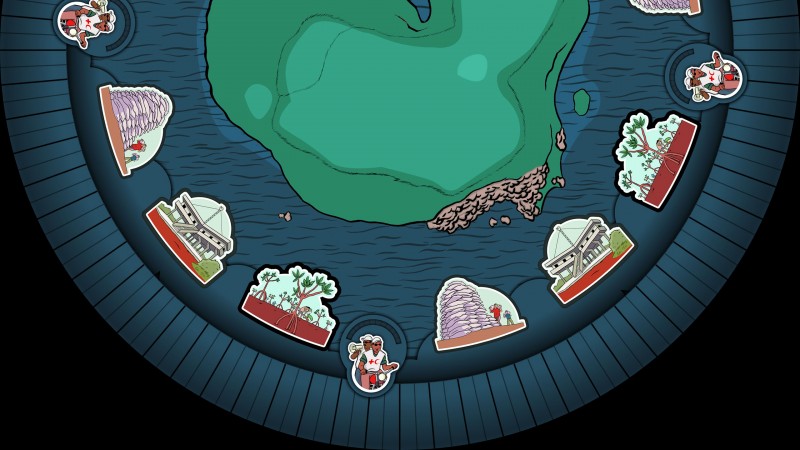Hurricane is a commission for the redevelopment of the International Red Cross and Red Crescent Museum in Geneva. Up to 25 players work together around a circular touch sensitive table to prepare their island for an incoming hurricane. Players must choose the right measures at the right time and then assemble teams of people to execute them. As the hurricane arrives they must evacuate everyone. And once the storm has passed they reflect on how many lives they saved.
From 2011 to 2013 the International Red Cross and Red Crescent Museum closed for a major refurbishment with new areas designed by Gringo Cardia, Diébédo Francis Kéré and Shigeru Ban. We were awarded the commission for a game in the Refusing Fatality area designed by Shigeru Ban. The game demonstrates the vital role that the Red Cross and Red Crescent plays in allowing communities to survive and recover from hurricanes and typhoons. The game reflects the ethos of the Red Cross and Red Crescent through an emphasis on prevention and strong partnerships with local communities. Every pound spent on prevention can save between two and ten pounds in disaster response and recovery costs.
The game is fast paced and collaborative. Facing each other across the table, players can easily work together even if they do not share a language. Play is easy and can be learnt by watching others play. The game centres on a large circular table with a capacitive touch system and eight video projectors mounted in the ceiling.
Players choose whether to plant mangroves, build shelters or stockpile food. Planting mangroves takes time to be effective but the plants lessen the impact of waves as they hit the shore. Building concrete shelters on stilts offers people a refuge. Although this is very expensive the buildings can be used by the community between storms as schools, for example. Stockpiling food can be done quickly and allows the community to bounce back quickly in the crucial days after a hurricane.
For each measure the players must choose the right mix of people to carry it out. They choose from Volunteers, Experts, Community Leaders, Villagers and Red Cross/Red Crescent Workers. Once the team has been assembled that measure can begin work.
All the while the players must remember to carry out Evacuation drills whenever they become available to keep the community ready to leave quickly and calmly when needed.
As the storm approaches and tension builds players must work faster. Once the storm arrives offshore it is too late to do anything except evacuate everyone to higher ground. The storm hits bringing a huge surge of water with it. The players learn how many islanders were saved and what they could try in the next game to improve their performance.
The game can be played by up to 25 players or by a single player. Players can join the game at any time and leave at any time. Each game lasts five minutes so it is easy to play more than once. The game is suitable for all ages and cultural backgrounds. Sound comes from headphones and from speakers mounted above the table. Rich audio and the voiceover for the game is delivered through headphones in French,German or English. Event sounds as measures are chosen and teams are assembled come from the speakers.
The game was designed in Flash by Jon Sutton and runs on a single PC with two quad head graphics cards, the illustration is by Pete Gamlen.
















